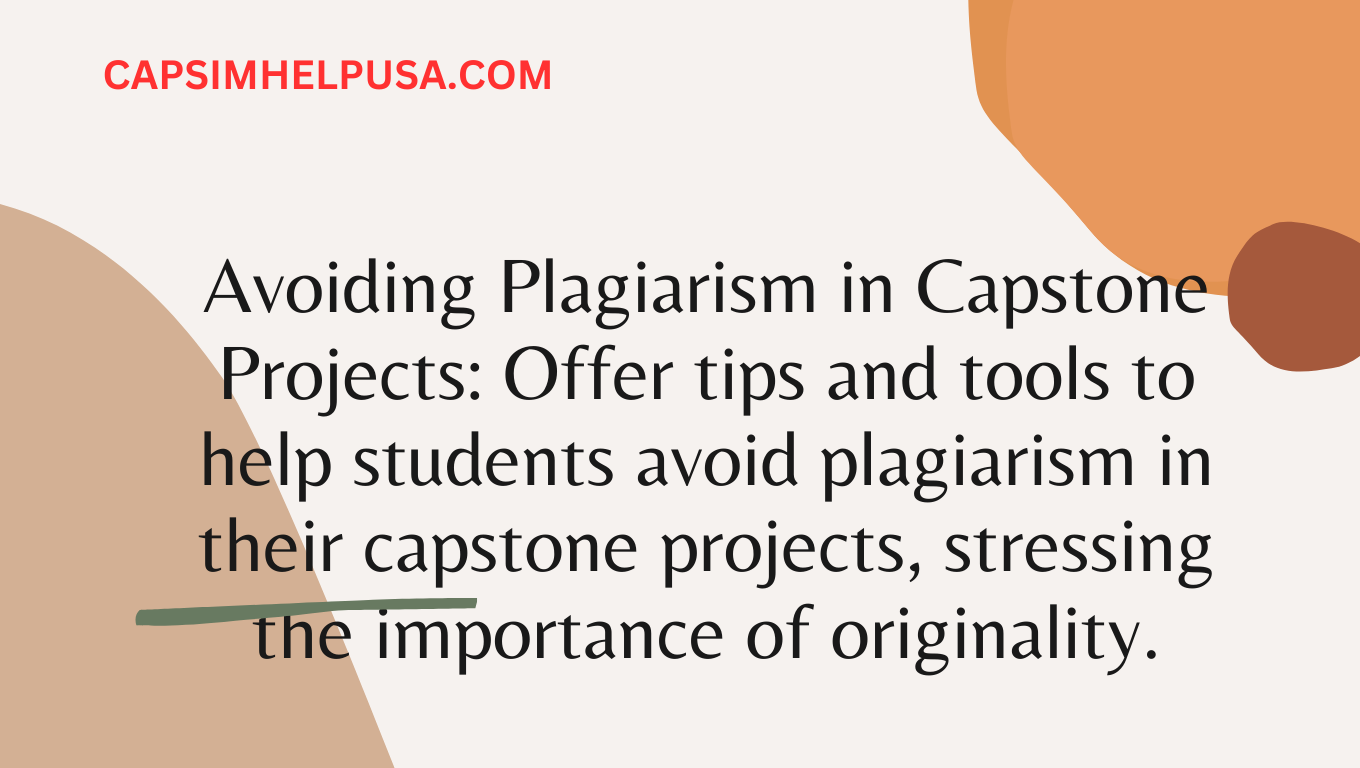Avoiding Plagiarism in Capstone Projects: Offer tips and tools to help students avoid plagiarism in their capstone projects, stressing the importance of originality.
Published by Rabia B. @

Table of Contents
Introduction
A.Plagiarism Definition
Plagiarism is copying someone else's work, ideas, or language. Copies, paraphrases, and self-plagiarism—reusing contributed work without credit—are examples. Because plagiarism harms academic integrity, schools penalize it.
B. Capstone Project Originality Matters
Capstone projects need creativity. Students' final projects show their topic mastery and ability to apply knowledge and abilities to real-world challenges. Capstone projects that are original demonstrate originality, critical thinking, and the capacity to advance the area. It sets a student's work apart and benefits the academic community.
C. Guide Purpose
This lesson teaches capstone project plagiarism prevention. Students may ensure their work is ethical and academically rigorous by understanding plagiarism, its consequences, and originality. Research, citation, and academic integrity tips will be available throughout the capstone project.
Knowing Plagiarism
A. Plagiarism Types
Copying without quotation marks or citations.
Paraphrasing without Citation: Restating someone else's ideas. Uncited sources are plagiarism.
Self-Plagiarism: Reusing previously contributed information without attribution deceives readers.
B. Effects of Academic Plagiarism
Assignment failure and academic expulsion might result from plagiarism. Academic integrity, the school, and research are damaged by plagiarism. Plagiarism hurts learning and betrays teachers and students.
Plagiarism Prevention Tips
A. Plan and Research Early
Early research gives you time to acquire, assess, and incorporate sources into your project. Planning your research keeps you organized and assures correct attribution.
B. Take Good Notes
Make careful to identify your own opinions from those of others while taking notes from sources. Write direct quotations in quotation marks and identify the author, title, and page number for reference.
C. Cite All Sources
APA, MLA, or Chicago should be used to reference any non-original concept, quotation, or material. Maintain citation style throughout your assignment and provide a bibliography or reference list with source data.
Know Paraphrasing from Plagiarism
You paraphrase someone else's thoughts while citing them. However, changing a few words or phrase structures without changing meaning constitutes plagiarism. Understand and convey the original content in your own words.
A. Check for Plagiarism
Use software or internet resources to examine your work for unintended plagiarism before submitting. To find citation-worthy similarities, these tools compare your content to a massive database of academic and internet sources.
B. Ask Instructors or Mentors
whether you're unclear how to properly acknowledge a source or whether your work is plagiarized, ask your teachers or mentors. They may help you fulfill academic criteria with feedback.
These recommendations and best practices for academic writing and research can help you preserve integrity in your capstone project and show your dedication to unique, scholarly work.
Plagiarism-Detecting Tools
Program to detect plagiarism The tool compares submitted work to a massive database of academic and online sources to detect plagiarism. Worldwide, schools use Turnitin. Turnitin provides instructors with a detailed report on source similarities. Plagiarism detection and grammar checking software Grammarly lets people write truly and accurately cite.
A. Tools for Citation Management
Zotero and Mendeley help academics organize and manage references. These applications let users gather, save, and organize citations from diverse sources and create bibliographies in multiple formats. Citation management software help students avoid plagiarism in capstone projects by ensuring precise and consistent source citation.
B. Online Plagiarism Checkers
Online plagiarism checkers like SmallSEOTools and Copyscape scan writing quickly and easily. Upload documents or paste text into the web interface to check for similarities with internet information. These tools make it easy to evaluate written work before submission, although they are not as thorough as plagiarism detection software.
Capstone Project Originality
A. Shows Subject Matter Mastery
Capstone projects demonstrate students' topic knowledge by being original. Students demonstrate their knowledge and skill in their subject by offering original ideas, insights, or solutions to real-world situations. Outstanding capstone projects are original and represent years of study and experience.
B. Promotes Academic Integrity
Originality is key to academic integrity in higher education. Students may show their integrity by creating original work and correctly citing sources and ideas for capstone projects. Originality promotes honesty, justice, and trust in academic societies, valuing intellectual property and rigor.
C. Improves Field of Study
Original capstone projects may advance their disciplines. Original work advances academic knowledge by revolutionary research, novel answers to practical issues, or incisive critiques of existing material. Students meet academic requirements and affect their fields by stressing uniqueness in capstone projects.
Case Studies
A. Capstone Project Plagiarism Examples
Copying directly: One student submitted a capstone assignment with full paragraphs copied from internet sources without citation. This obvious plagiarism was caught by the teacher using plagiarism detection software, resulting in harsh penalties for the student.
Another student tried to paraphrase scholarly texts without acknowledgment. The student rewrote the information, but the absence of citation made it plagiarism and tarnished the effort.
B. Student Penalties for Plagiarism
Plagiarism in capstone projects may result in poor marks, academic probation, or expulsion. Student academic records and reputations are tarnished by plagiarism, threatening employment and further study. It also damages student-teacher trust and the school's reputation.
C. Originality-Focused Student Success Stories
However, innovation in capstone projects has helped many students succeed. These students have won awards for their comprehensive study, critical literature analysis, and inventive solutions or discoveries. Peers and teachers have acknowledged their innovative contributions, opening doors to academic, industrial, and other professional prospects.
Conclude
A. Summary
In conclusion, capstone projects must be unique to demonstrate academic integrity and topic competence. Students must comprehend plagiarism, use proper tools and resources to prevent it, and emphasize ethics throughout the project. if you are looking for help in your Capstone Simulation Help. Contact us!
B. Promoting Student Originality
Students should embrace the challenge of creating creative capstone projects that represent their unique views, insights, and contributions to their area of study. Students meet academic standards and affect their fields and communities by valuing creativity.
Students may handle capstone projects with integrity and brilliance by grasping the value of uniqueness, using suitable tools and resources, and following ethical norms.





